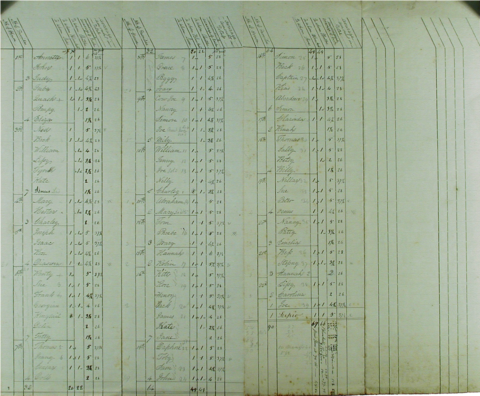Voted the Best Place to See by Condé Nast Traveler.


List of Enslaved Families, Drayton Hall, 1849 – 1865. Drayton Papers Collection
On Juneteenth (June 19th), we recognize the day that all Americans became free. Today, we take time to acknowledge the evils of slavery and its aftermath, while celebrating the resilience of Black Americans through the centuries.
At Drayton Hall, we are recognizing Juneteenth this year by launching an online exhibit, Documentation of the Enslaved and Free African American Communities at Drayton Hall. This exhibit is designed to be a resource for those looking for information about their ancestors, as well as anyone wanting to learn more about slavery and the postbellum African American community at Drayton Hall. Tracing African American family histories is challenging, as slavery and institutional racism rendered many records incomplete or inaccessible. Researchers and family members often cannot break through the 1870 “Brick Wall,” referring to the 1870 U.S. Census, the first census taken after Emancipation, and the first time formerly enslaved people were listed with surnames. Prior to 1870, it is extremely difficult to trace one’s ancestry because enslaved individuals were only recorded by first name, if at all.
This exhibit includes several lists of enslaved individuals who lived at Drayton Hall and other Drayton-owned plantations. These documents may be the key for many people in the descendant community seeking more information about their ancestors, especially when paired with DNA testing. Additionally, historic photographs, census records, maps, and artifacts comprise the exhibit. The intention of the online exhibit is to provide an organized and accessible path to the historical documents related to the enslaved and free Black residents of the property that are contained in the archival collections at Drayton Hall and other local repositories such as the South Caroliniana Library at the University of South Carolina and the South Carolina Historical Society.
Learn How Enslaved People at Drayton Hall May Have Learned of Their Freedom…
While June 19, 1865 marked the end of slavery for those who received word from Union soldiers in Galveston, Texas, many enslaved people in the Charleston area may have heard the news of freedom in February of 1865.
Enslaved individuals at Drayton Hall may have heard of their freedom from Dr. Henry Orlando Marcy, a surgeon who served in the 35th Regiment of the US Colored Troops. Dr. Marcy kept a diary, and on February 23, 1865 he wrote about travelling to Middleton Place, four miles up Ashley River Road from Drayton Hall. He wrote, “All here was confusion—they had heard the news from their friends and they were making ready to leave.” Marcy was referring to the formerly enslaved people he met at Middleton Place who had just heard about the surrender of the city of Charleston to Union troops, who brought with them the message of freedom for all enslaved people.
After leaving Middleton Place, Dr. Marcy and his troops went to another plantation that he described as being “very old with a hip roof-brick,” which was most likely Drayton Hall. He continued, “Here find overseer and wife. Select several things_ Tell the slaves of their freedom Find a quantity of corn meal etc. and return.” While it is not known who the overseer and the enslaved people were, our best guess comes from a document in the online exhibit, “Tax Return of Drayton Hall,” which dates to 1860. That tax return lists 31 enslaved people by name. However, we do not know if they all still lived at Drayton Hall five years later when Dr. Marcy went there.
At every plantation that Dr. Marcy went to, he wrote that he told enslaved people they were free. While there are no accounts from the people he spoke to, interviews with formerly enslaved people collected in the 1930s as part of the Federal Writers’ Project give us some indication of the different ways enslaved people learned of their freedom. Some people said they heard about the Emancipation Proclamation in 1863, others remembered their owners telling them they were free when the Civil War ended. Some said they heard the news from a Freedmen’s Bureau worker, and others recalled Union soldiers bringing the news of freedom.
John Drayton, one of the Drayton brothers who co-owned Drayton Hall during the Civil War, lived at Drayton Hall until he fled from Charleston in February 1865. Did he tell the people he enslaved that they were free before he left? Or did those people hear it for the first time from Dr. Marcy? We may never know, but we celebrate that freedom today and every day.
We hope that you will access Documentation of the Enslaved and Free African American Communities at Drayton Hall to read the names of those individuals who were enslaved at Drayton Hall and who received the news of freedom. We hope this exhibit provides a continuing reference for those looking for information on their families and histories now and for generations to come.